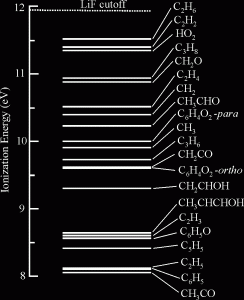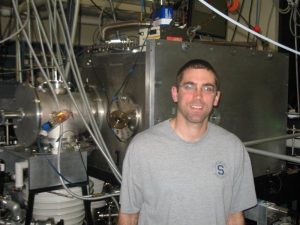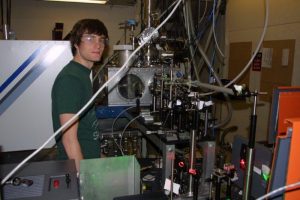 In the past, many of the experimental advances in the field of molecular reaction dynamics of neutral species have involved the detection of nascent products from photodissociation or bimolecular reactions under single-collision conditions. Such experiments have typically employed mass spectrometry using electron impact ionization, or optical methods such as laser induced fluorescence (LIF) or resonance enhanced multiphoton ionization (REMPI). While electron impact ionization can be used to detect any neutral species, detection sensitivity is limited by the small ionization efficiencies (typically less than 0.01%), and large background signals due to dissociative ionization. Although LIF and REMPI offer much greater sensitivity, these methods require that the spectroscopic fingerprints of the detected molecules be well-known. While the electronic spectroscopies of atomic and diatomic molecules are in most cases well-understood, the same can be said for only a small number triatomic and larger molecules. These issues have constrained most studies in the field to simple reactions leading to diatomic or triatomic molecules.
In the past, many of the experimental advances in the field of molecular reaction dynamics of neutral species have involved the detection of nascent products from photodissociation or bimolecular reactions under single-collision conditions. Such experiments have typically employed mass spectrometry using electron impact ionization, or optical methods such as laser induced fluorescence (LIF) or resonance enhanced multiphoton ionization (REMPI). While electron impact ionization can be used to detect any neutral species, detection sensitivity is limited by the small ionization efficiencies (typically less than 0.01%), and large background signals due to dissociative ionization. Although LIF and REMPI offer much greater sensitivity, these methods require that the spectroscopic fingerprints of the detected molecules be well-known. While the electronic spectroscopies of atomic and diatomic molecules are in most cases well-understood, the same can be said for only a small number triatomic and larger molecules. These issues have constrained most studies in the field to simple reactions leading to diatomic or triatomic molecules.
Vacuum ultraviolet and extreme ultraviolet radiation can be used for “soft” single-photon nonresonant ionization of molecules. The only requirement is that the energy of the photon must exceed the ionization energy of the molecule of interest (see figure above). Using single-photon ionization, high detection sensitivity is possible even when the spectroscopy of the molecule or radical under interrogation is unknown. In the past, intense sources of such short-wavelength radiation have been largely restricted to 3rd generation synchrotron light sources only available at a few locations worldwide. While the upconversion of visible and UV lasers to the VUV and XUV using nonlinear optical methods such as 4-wave mixing in inert gases is well-established, the efficiencies of such techniques are typically too low (<<1%) to facilitate nonresonant photoionization methods.
 To greatly expand the range of chemical systems that can be studied, we have developed new light sources in the VUV and XUV based on near-triple resonant 4-wave mixing of high-intensity visible and near-UV radiation produced by tabletop laser sources. This produces intensities in the VUV and XUV that are two to three orders of magnitude higher than is normally possible. For example, 10 eV (125 nm) pulsed radiation at the millijoule level can be used for “soft” photoionization of products from crossed molecular beams reactions using a rotatable source apparatus. We are now able to study reactions of polyatomic free radicals (e.g., C6H5 + O2), or reactions of transition metal atoms having higher ionization energies (Pt + CH4), or ligand exchange reactions of transition metal complexes (e.g., C5H5CoH2 + C3H6), reactions of halogen oxide molecules relevant to stratospheric ozone destruction, or even reactions on Saturn’s moon Titan.
To greatly expand the range of chemical systems that can be studied, we have developed new light sources in the VUV and XUV based on near-triple resonant 4-wave mixing of high-intensity visible and near-UV radiation produced by tabletop laser sources. This produces intensities in the VUV and XUV that are two to three orders of magnitude higher than is normally possible. For example, 10 eV (125 nm) pulsed radiation at the millijoule level can be used for “soft” photoionization of products from crossed molecular beams reactions using a rotatable source apparatus. We are now able to study reactions of polyatomic free radicals (e.g., C6H5 + O2), or reactions of transition metal atoms having higher ionization energies (Pt + CH4), or ligand exchange reactions of transition metal complexes (e.g., C5H5CoH2 + C3H6), reactions of halogen oxide molecules relevant to stratospheric ozone destruction, or even reactions on Saturn’s moon Titan.
Our ultrabright VUV source at 130 nm improves our sensitivity in oxygen atom Rydberg tagging TOF (ORTOF) spectroscopy, a method developed in our laboratory, by at least two orders of magnitude. In this case, three input laser beams for VUV generation by four-wave mixing are each tuned near atomic resonances in the nonlinear medium. By combining this method with the use of narrowband lasers, we have reached the point where the first true crossed beam study of the H + O2 → OH + O reaction, generally considered to be the single most important reaction in combustion, is possible.
In the photos below, Dan Albert is working on the Rydberg O atom Machine. Three tunable dye lasers are used to produce the 130 nm VUV light, and a fourth laser in foreground is used to excite the O(3S) to a high-n Rydberg state. The crossed beams machine is at the right edge of the photo below.
Dan standing in front of the rotatable detector crossed beams apparatus.
In the photo to the right, Michael is in the laboratory working on an XUV light source, which provides intense pulsed light with photon energies up to 13.8 eV. In recent work, we developed the capability of producing short wavelength radiation via noncollinear mixing of input lasers in laser vaporized media. A paper describing this work is available here:58-27p0ak3 Using noncollinear mixing of focused input laser beams in laser vaporized Hg , we were able to produce VUV and XUV wavelengths ranging from λ = 125 nm (9.9 eV) to λ = 89.6 nm (13.8 eV) utilizing two photon resonances in Hg. Using this method, the two input laser beams are crossed at a small angle in the nonlinear medium. The resulting short wavelength radiation emerges at a different angle from the unconverted fundamental beams, eliminating the need for gratings. Like Peet et al and Ubachs and coworkers, we have shown that noncollinear mixing of focused beams produces VUV intensities comparable to the collinear focused approaches. However, intensities obtainable using Hg are significantly higher.
